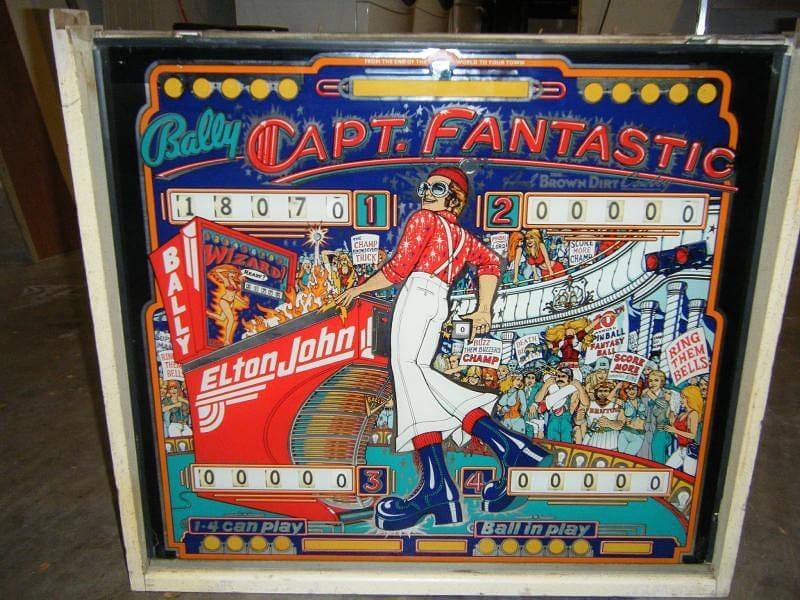


'Capt. Fantastic' was inspired by the movie 'Tommy' and includes a representation of Elton John, as his character from the movie, playing pinball on the backglass. The game name, however, is the title of Elton John's 1975 autobiographical song and album where "Captain Fantastic" was Elton and "The Brown Dirt Cowboy" was his then-lyricist Bernie Taupin. Included in the song lyrics are the words "From the end of the world to your town" which appear at the very top center of the backglass. Tom Nieman, VP of Marketing for Bally Pinball, tells us the flyer was made while Elton was recording a new album in Canada. For this flyer, a game was shipped to the Toronto hotel where Elton was staying. That is why he is shown wearing a Canadian hockey jersey. Elton then asked Nieman to send a game to his various residences and one to his "mum" in the UK. Artist Dave Christensen included in the backglass several depictions of people doing things that, at first, escaped notice by Bally management. A small number of games with these so-called "X-rated" or "uncensored" backglasses made it through production before changes were required to be made. Specifically, small mirrored stars were added over the objectionable parts and, curiously, these stars did not effectively obscure the offending art in all instances. Nieman explained to us that he and Christensen wanted the correction to be as minimal as possible because they knew they had "a monster hit" on their hands. The X-rated version is often referred to as the "no stars" version even though all of the backglasses in the production run did contain a certain number of peripheral decorative stars anyway. Nieman is depicted in the backglass as the man in the three-piece suit, and he says that 'Brutus' is artist Paul Faris. Mr. Nieman attended the 1975 New York premier party for the movie "Tommy" held in the 57th Street subway station. He had agreed with artist Christensen to represent the date of this event in the backglass art as the score 31775. A biography of Keith Moon records the date of this party as March 18, 1975. It is easy to believe that the party extended over both days. Bally made an unknown quantity of playfields for this game having orange star rollover inserts instead of the usual green ones. This version is seldom seen, which indicates the quantity made was small. Pictured in this listing are three different examples of this "orange version" playfield. Two of the three also have a white drop target Special insert, instead of the expected red-colored one. The production run of this game was over 16,000 units, and these "orange version" playfields may have simply resulted from spot shortages during the production run of playfield parts having the correct colors. More information is needed to understand the reason for these playfield differences. The Early Production game pictured here has serial number 1088 and has green star rollover inserts on its playfield. It has the Over The Top backglass which is uncensored and, like the game in the flyer, its cabinet front has the "reversed" red and blue striping as compared to the striping on the cabinet sides. Included in this listing is a playfield showing signatures of both the designer and artist silkscreened in the black area at the bottom where the outlanes exit towards the outhole. Greg Kmiec tells us that Christensen had sneaked their signatures there but when Bally management heard about it and saw it, they made Christensen remove the signatures. Greg initially stated that only ten playfields were produced like this in a pilot run, not to appear on production games, but when the production game with serial number 1087 was identified as having a signed playfield, it caused him to wonder if a larger quantity of, say, 100 was actually made, to have appeared on production games. Another explanation would be that game 1087 was retrofitted with a pilot run playfield after it left the factory. We note that the game with serial number 1088 does not have a signed playfield. One game in this listing has a backbox frame painted red instead of the usual white. We have no further information on this except the same variation has been seen on Bally's 1978 'Bobby Orr Power Play'. A home version of this game was also produced; see Bally's 1977 'Captain Fantastic & The Brown Dirt Cowboy'.
Loading leaderboard...